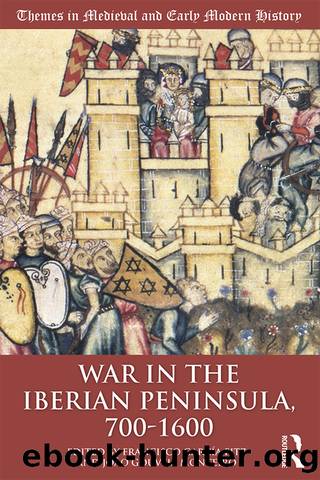War in the Iberian Peninsula, 700â1600 by Francisco García Fitz & João Gouveia Monteiro

Author:Francisco García Fitz & João Gouveia Monteiro
Language: eng
Format: epub
Publisher: Taylor and Francis
Chains of command
The organization of chains of command in the Late Middle Ages reproduced the general principle of the previous period, according to which the authority shared over the different bodies of combatants was directly related to the military potential of the different powers gathered on each occasion. Due to this, the holders of more powerful lordships and/or fiefs occupied a higher position in the leadership of the armies. However, the process of centralization of political power around the monarchy and the consequent strengthening of state institutions led, after 1300, to the emergence of positions and offices with large military faculties authorized to control the troops mobilized by aristocracy and municipalities.
These responsibilities fell into two distinct areas in terms of their legal framework, but were very closely related to each other from a social point of view, since they were often carried out by men from the same social networks. The first of them was the kingâs household, which included the positions of senescal, already existing in the previous period. From 1330, this position belonged to the counts of Prades, through the concession of Alfonso IV, but in 1369, Pedro IV decided to buy the rights for this and to give it to the prince MartÃn, future MartÃn I the Humane (1396â1410). That same year, the monarch created the office of condestable, following the example of the organization of the French kingâs household. Under the two previous figures, from 1344 there had also been two sheriffs and eight ushers of arms; and later, a marshal, a position held by Guerau de Queralt in 1389 (Ferrer i Mallol 2001: 188â189; Sáiz Serrano 2008: 76â84).
The second area includes the institutions of each of the territories, the holders of which generally acted in harmony with the military posts belonging to the kingâs household. The first of the positions of power with specific competences in the military area in the Crown of Aragon was the general lieutenancy of the monarch, also called, in time of war, capitanÃa general (general captain). This position involved the temporary delegation of all the powers and functions of the sovereign to a loyal person, usually a member of the royal family or of the highest aristocracy. Together with the general lieutenancy, there was also the general governance, a function symbolically linked to the throneâs heir from 1350 and played by a knight in each of the territories of the Crown. Unlike the lieutenancy of the king, general governance was a permanent position.
A level below the lieutenancy and the general governor there were the territorial captaincies, positions of a temporary character that granted their holders broad powers over the population and companies located in a specific area of the territory, always within royal jurisdiction. The position of alcaide was closely related to that of captain. Alcaides were responsible for defending a castle and its borders. Under the authority of captains and alcaides, there were the sergeants (cabos), which can be defined as the most elementary position among the commanders of the army.
Download
This site does not store any files on its server. We only index and link to content provided by other sites. Please contact the content providers to delete copyright contents if any and email us, we'll remove relevant links or contents immediately.
| Automotive | Engineering |
| Transportation |
Machine Learning at Scale with H2O by Gregory Keys | David Whiting(4190)
Never by Ken Follett(3797)
Urban Outlaw by Magnus Walker(3342)
OPNsense Beginner to Professional by Julio Cesar Bueno de Camargo(3251)
Sapiens and Homo Deus by Yuval Noah Harari(2987)
Will by Will Smith(2794)
A Short History of Nearly Everything by Bryson Bill(2629)
Hooked: A Dark, Contemporary Romance (Never After Series) by Emily McIntire(2502)
Rationality by Steven Pinker(2291)
Borders by unknow(2232)
The Becoming by Nora Roberts(2089)
Holy Bible (NIV) by Zondervan(2087)
The One Percenter Encyclopedia by Bill Hayes(1787)
HBR's 10 Must Reads 2022 by Harvard Business Review(1778)
Freedom by Sonny Barger(1772)
A Short History of War by Jeremy Black(1763)
Five Ways to Fall by K.A. Tucker(1702)
Go Tell the Bees That I Am Gone by Diana Gabaldon(1689)
Girls Auto Clinic Glove Box Guide by Patrice Banks(1685)
